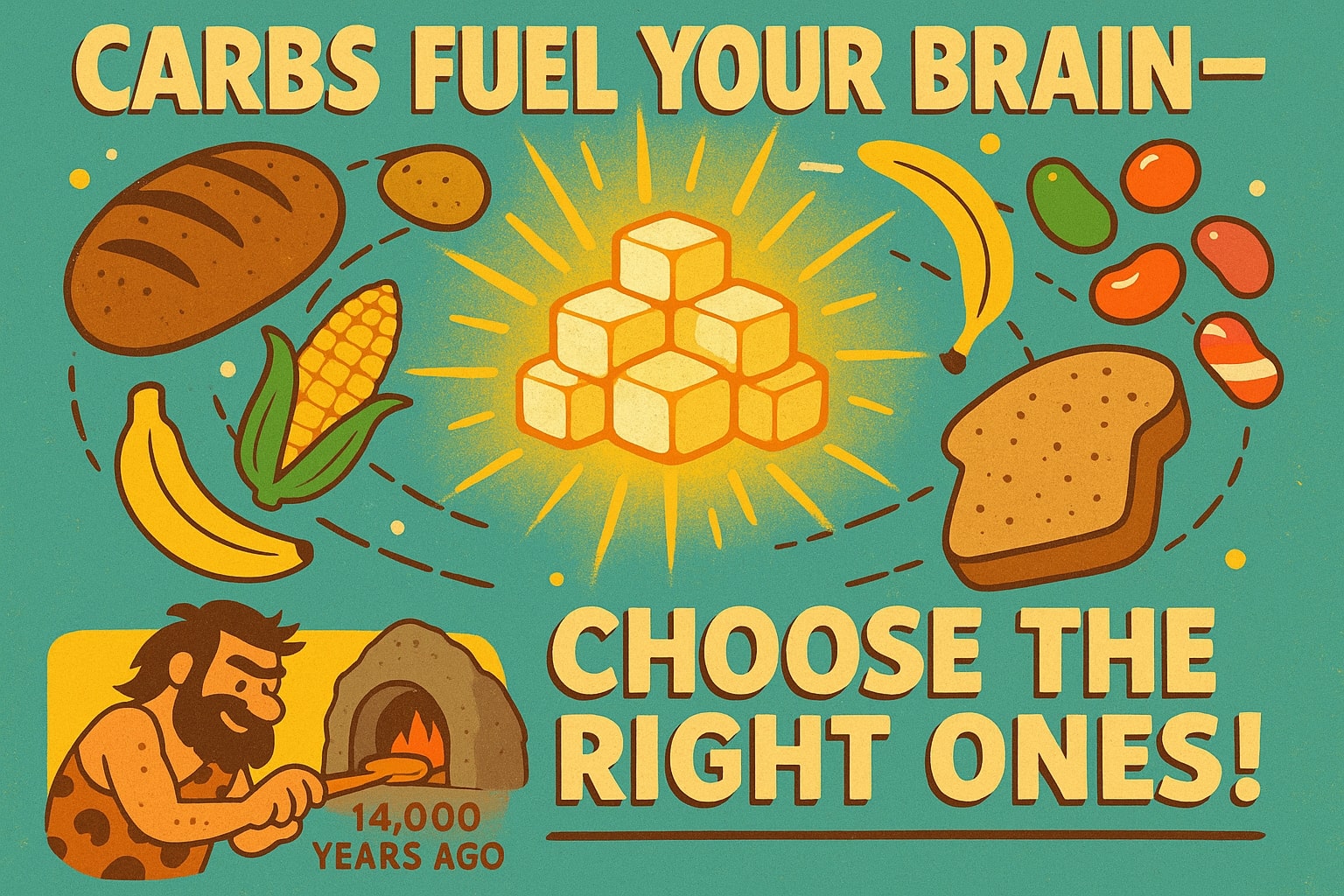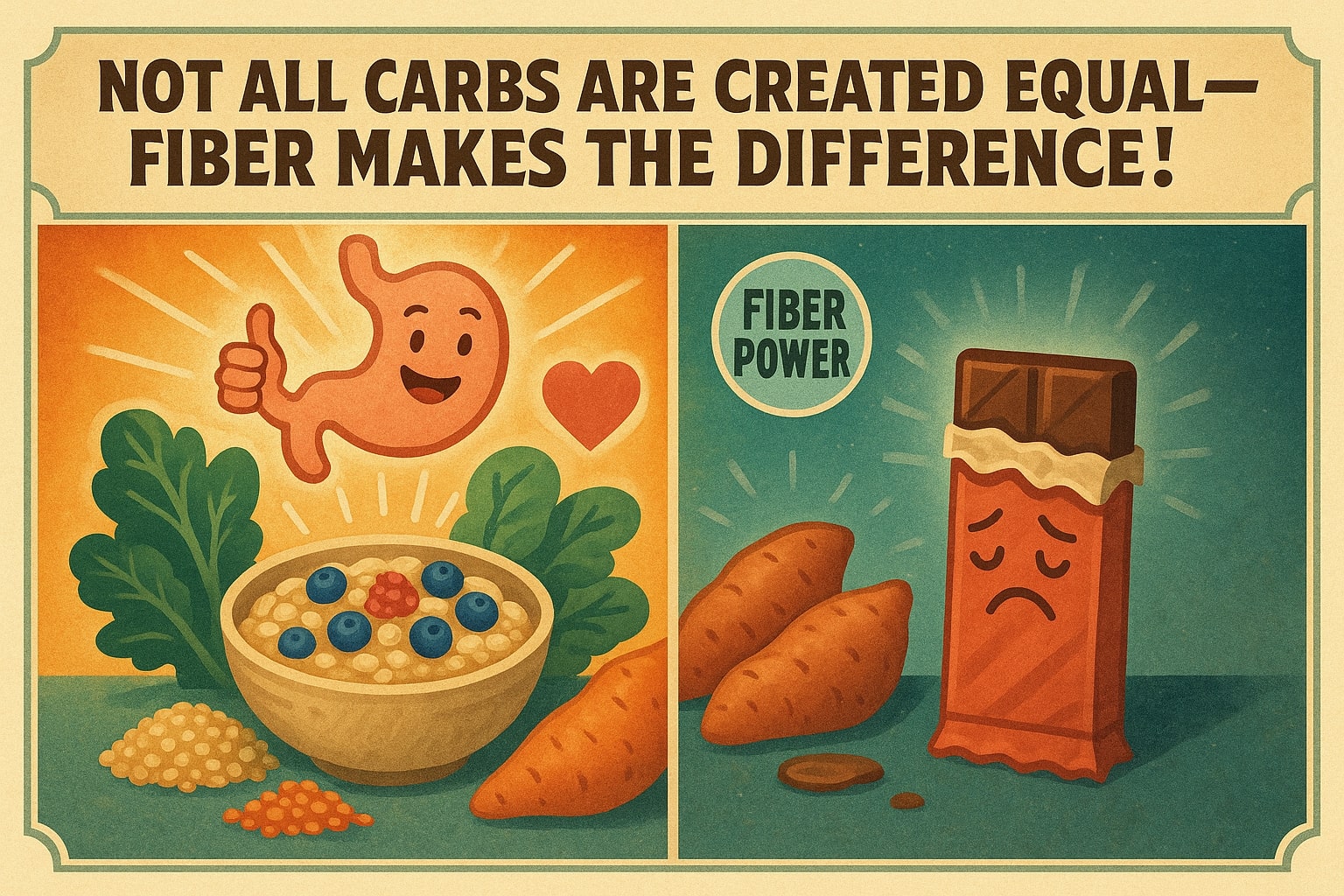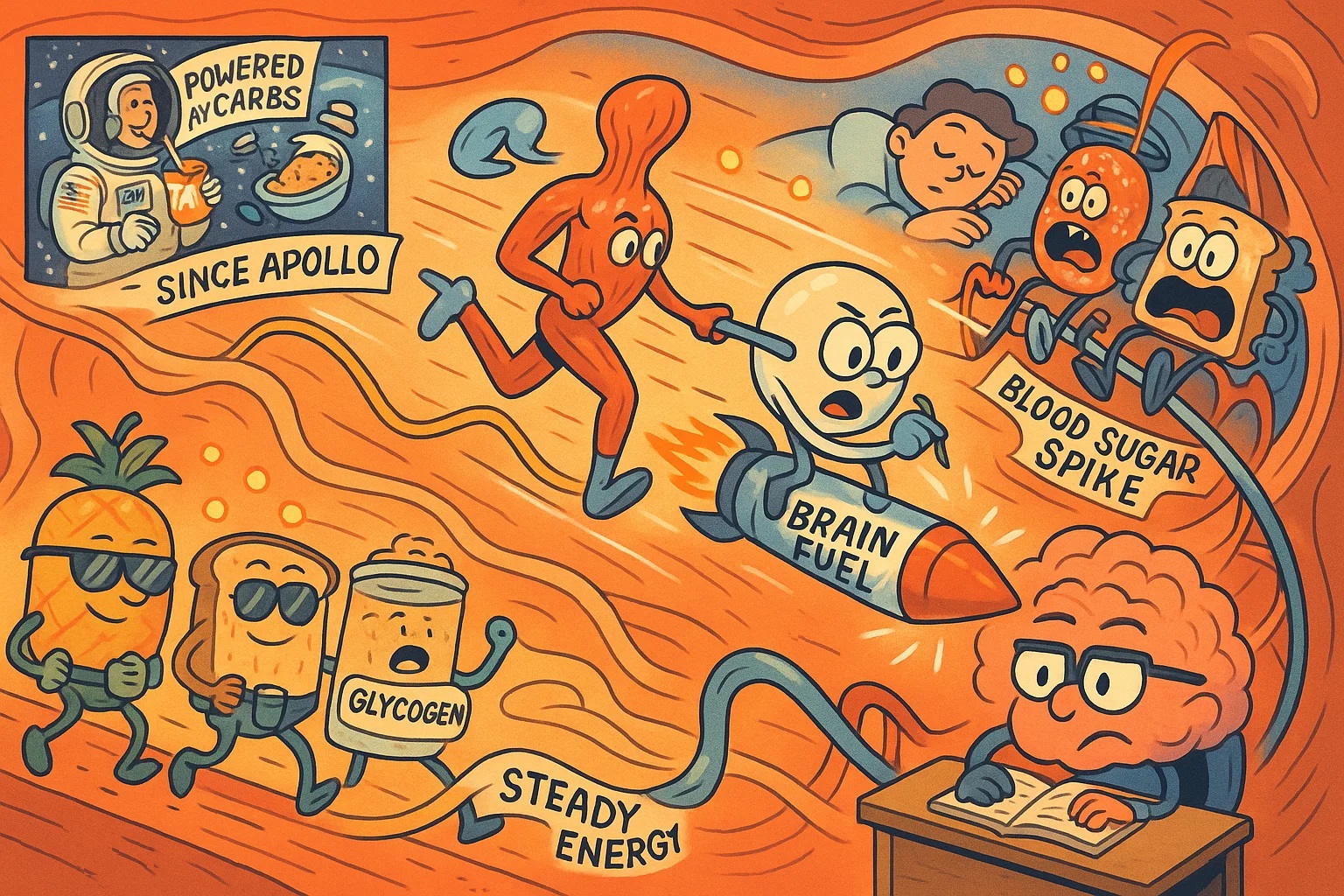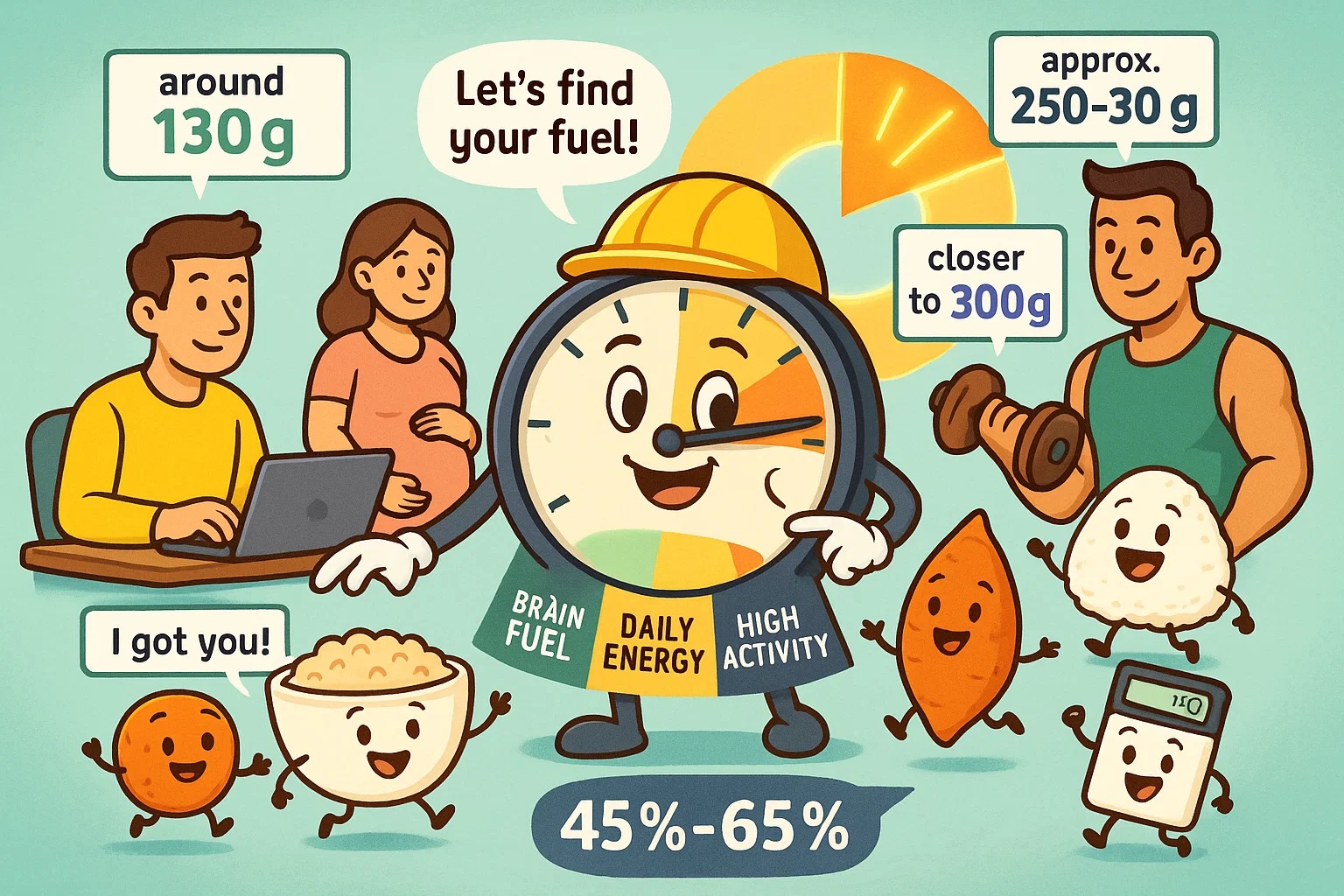Carbohydrates are often misunderstood, lumped into categories like “good” or “bad.” But in reality, they’re a vital part of your daily nutrition. In this article, we’ll dive into the science of carbs, explain their role in the body, and bust a few common myths along the way.
What Are Carbohydrates?
Carbohydrates are one of the three essential macronutrients the body needs—alongside proteins and fats. Among the three, carbohydrates are typically the body’s preferred energy source, especially for the brain, nervous system, and muscles during physical activity.
💡 Fun fact: Your brain alone uses about 20% of your body’s total energy, most of it coming from glucose—even at rest!
At the molecular level, carbohydrates are made of carbon, hydrogen, and oxygen. These compounds break down during digestion into glucose, the primary sugar the body uses for fuel. Glucose is either used immediately for energy or stored in the liver and muscles as glycogen for later use.

Carbohydrates are generally classified into three main types:
-
Sugars – These are the simplest form of carbohydrates. They occur naturally in foods like fruits (fructose), milk (lactose), and vegetables, but are also added to processed foods such as sodas, candies, and pastries (often as sucrose or high-fructose corn syrup).
-
Starches – Made up of long chains of glucose, starches are found in plant-based foods like grains, legumes, potatoes, and corn. They’re considered complex carbohydrates because they digest more slowly and deliver a longer-lasting energy source.
-
Fiber – Unlike other carbs, fiber can’t be digested by the body. Still, it plays a vital role in maintaining health. Found in whole grains, fruits, vegetables, legumes, and nuts, fiber helps support digestion, reduce cholesterol, and stabilize blood sugar levels.
From a nutrition perspective, carbohydrates are typically divided into two main categories:
-
Simple carbohydrates are sugars with a basic molecular structure. They digest quickly, often leading to sharp spikes in blood sugar, followed by sudden energy crashes. These are commonly found in sugary drinks, desserts, and processed snacks.
-
Complex carbohydrates consist of longer chains of sugar molecules and take longer to break down. As a result, they help maintain stable blood sugar, offer a steady energy source, and are found in foods like whole grains, legumes, and vegetables.
Although carbs often get a bad reputation, they’re not inherently unhealthy. In fact, whole, fiber-rich carbohydrates are linked to better long-term health, including a lower risk of heart disease and improved digestion. The key is to prioritize quality over quantity—choosing minimally processed, nutrient-dense options over refined sugars that offer little nutritional value.
💡 Did you know? The earliest evidence of bread-making dates back over 14,000 years—long before formal agriculture even began.
Simple Carbohydrates
Let’s begin with simple carbohydrates. These are the most basic types of sugars, made up of just one or two sugar molecules. They’re rapidly digested, which causes a quick spike in blood sugar. That burst of energy might feel great at first (hello, sugar rush), but it’s often followed by a crash—which can affect your focus, mood, and energy levels throughout the day.
You’ll find simple sugars in foods like table sugar, sodas, candies, pastries, and many ultra-processed snacks. But not all simple sugars are harmful. They also occur naturally in whole foods like fruits and dairy, which provide fiber, vitamins, and minerals along with the sugar.
The real concern is with added sugars—the kind manufacturers mix into things like sauces, cereals, and sweetened beverages. When consumed in excess, these are linked to health risks such as weight gain, insulin resistance, and type 2 diabetes.
Complex Carbonhydrates
Now, on the other end of the spectrum, we have complex carbohydrates. These are built from longer chains of sugar molecules, which means your body takes more time to digest them. The result? Steadier blood sugar, longer-lasting energy, and increased satiety—in other words, you’ll feel full for a longer period.
You’ll find complex carbs in nutrient-rich foods like:
-
Whole grains (brown rice, oats, quinoa — and you can see how this fits into your daily needs using our Calorie Calculator)
-
Legumes (lentils, beans, peas)
-
Vegetables, especially starchy varieties like sweet potatoes and carrots
These foods are often rich in fiber, which doesn’t just help with digestion—it also supports heart health, helps regulate cholesterol, and may even reduce the risk of certain cancers, according to recent research¹.
If there’s one thing to remember, it’s this: carbs aren’t the enemy—what matters is the context. A candy bar and a bowl of oats might both count as carbohydrates, but your body processes them very differently. It’s not just the carb content that counts—it’s what’s packaged with it: fiber, nutrients, and balance.
Curious about your protein needs too? Check them with our Protein Calculator.

Carbohydrates and Energy
Ever notice how sluggish you feel when you skip meals or cut out carbs completely? That’s your body signaling that it’s missing its favorite energy source: carbohydrates.
Carbs are the body's primary fuel, quickly and efficiently turned into glucose—a type of sugar that powers everything from your brain to your muscles. As soon as you eat carbs—whether from fruit, rice, or whole-wheat bread—your digestive system breaks them down into glucose. This glucose travels through the bloodstream, where it’s either used immediately or stored as glycogen in your muscles and liver for later.
And it's not just athletes who rely on carbs. Your brain alone needs about 120 grams of glucose daily to function properly². That’s why low-carb diets can leave you feeling foggy, tired, or cranky—it’s not all in your head (well, technically, it is).

Here’s how carbs support your body throughout different activities:
-
Daily activities like walking, working, or thinking are fueled by glucose from the carbs you eat.
-
During workouts, your muscles tap into glycogen stores for quick energy.
-
Post-exercise, carbs help rebuild glycogen, repair tissue, and speed up recovery. Want to understand your energy needs better? Try our BMR Calculator.
Even while you sleep, your body uses glucose for essential functions like breathing, cell repair, and brain activity. That’s why carbs are especially important for growing children, pregnant women, and athletes—but really, everyone needs them.
Of course, not all carbs are created equal. Refined carbs (like white bread and sugary drinks) burn fast, causing blood sugar spikes and crashes. In contrast, complex carbs (like oatmeal or lentils) break down more slowly, giving you steady, lasting energy.
Bottom line: If you want more energy, better workouts, or clearer thinking, don’t be afraid of carbs. Just choose wisely and eat the amount that suits your lifestyle.
🧠 True story: During the early NASA missions, astronauts were fed carb-heavy options like Tang and freeze-dried pasta. Not exactly gourmet—but carbs delivered the reliable energy they needed in space.
How Many Carbs Should I Intake a Day?
It’s one of the most common nutrition questions—and the truth is, the answer depends on you. Your age, activity level, goals, and even your metabolism all influence how many carbohydrates your body needs.
Still, there are some general, evidence-based guidelines. According to the Dietary Guidelines for Americans, most people should get 45% to 65% of their total daily calories from carbohydrates. That means:
-
If you eat 2,000 calories a day, you’d typically need around 225 to 325 grams of carbs.
-
The minimum recommended amount is 130 grams per day, which is enough to support healthy brain function.
But keep in mind, these numbers are just a starting point. If you’re an athlete, pregnant, or dealing with specific health concerns like diabetes or metabolic syndrome, your needs may vary.

Carb intake is usually calculated based on your TDEE (Total Daily Energy Expenditure), which uses your weight, height, activity level, and goals. If you already know your TDEE, you're one step ahead. If not, try using our TDEE Calculator to find your baseline.
💡 Fun fact: Endurance athletes can need up to 70% of their daily calories from carbs to support performance and recovery.
Check out Health section to find the tool you need for your health
Here’s a rough breakdown of typical carb needs based on activity:
|
Lifestyle Type
|
Carb Range (grams/day)
|
|
Sedentary
|
130–180 g
|
|
Lightly Active
|
180–230 g
|
|
Moderately Active
|
230–300 g
|
|
Very Active (Athletes)
|
300–450+ g
|
The quality of those carbs matters just as much as the quantity. A diet filled with whole grains, legumes, fruits, and vegetables gives your body long-lasting fuel, fiber, and essential nutrients—not just calories.
- Harvard T.H. Chan School of Public Health. “Carbohydrates and Blood Sugar.”
-
Institute of Medicine. "Dietary Reference Intakes for Energy, Carbohydrate, Fiber, Fat, Fatty Acids, Cholesterol, Protein, and Amino Acids." National Academies Press.





